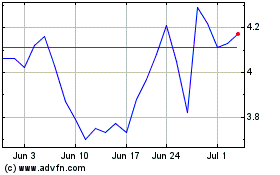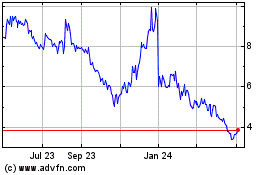Anavex Life Sciences Corp. (“Anavex” or the “Company”) (Nasdaq:
AVXL), a clinical-stage biopharmaceutical company developing
differentiated therapeutics for the treatment of neurodegenerative,
neurodevelopmental, and neuropsychiatric disorders including
Alzheimer’s disease, Parkinson’s disease, Rett syndrome,
schizophrenia, and other central nervous system (CNS) diseases,
today presented comprehensive results from the Phase IIb/III study
showing that blarcamesine (ANAVEX®2-73), once daily orally,
significantly slowed clinical decline in people with early
Alzheimer's disease (AD). The data were presented by Marwan Noel
Sabbagh, MD, Professor of Neurology at Barrow Neurological
Institute and Chairman of the Scientific Advisory Board at the 2024
Alzheimer's Association International Conference (AAIC).
Blarcamesine significantly slowed clinical
progression by 38.5% and 34.6% at 48 weeks in 50 mg and 30 mg
groups vs. placebo, respectively, on the prespecified primary
cognitive endpoint ADAS-Cog13. As specified in the March 2024 FDA
Guidance for Early AD, a sole cognitive measure can serve as the
primary endpoint for early Alzheimer’s trials.1 The protocol was
designed with ADAS-Cog13 and ADCS-ADL as co-primary endpoints. The
functional co-primary endpoint, ADCS-ADL, was trending positive but
did not reach significance at Week 48. A possible explanation is
that the ADCS-ADL scale is designed for AD with overt dementia and
is less sensitive for early AD.2 The prespecified key secondary
composite endpoint CDR-SB, also recommended as an alternative
primary endpoint for early AD in the new FDA guidance, is
significant at both 30 mg and 50 mg at Week 48. The findings are
supported by biomarkers from the A/T/N spectrum, including plasma
Aβ42/40-ratio and reduction of brain atrophy. Blarcamesine
significantly slowed brain atrophy in key regions of interest,
including the whole brain by 37.6%, total grey matter by 63.5%, and
lateral ventricles by 25.1%.
“These data are very exciting, particularly in a
study that can demonstrate objective slowing of markers of
neurodegeneration,” said Dr. Sabbagh. “The advantage of
blarcamesine is that it is a small oral molecule that exerts
clinical benefits on cognition and neurodegeneration and could be
appealing because of its route of administration and good
comparative safety profile. The neuroimaging evaluation performed
in the Phase IIb/III study demonstrated no neurological tissue
damage such as hemorrhage or Amyloid-related imaging abnormalities
(ARIA), as documented with other anti-amyloid targeted therapies.
We believe the scalable and convenient features of blarcamesine
could reduce crucial barriers within the currently complex
healthcare ecosystem for Alzheimer's disease and provide broader
access to a diverse population with early Alzheimer's disease.”
Blarcamesine, a small molecule administered
orally once daily, demonstrated numerically superior clinical
efficacy to approved therapies while also slowing neurodegeneration
in early AD patients. Blarcamesine’s safety profile indicates not
requiring routine MRI monitoring, and given its differentiated
mechanism of action, could represent a novel treatment that could
be complementary to the currently approved anti-beta amyloid
monoclonal antibody drugs.
Juan Carlos Lopez-Talavera, MD, PhD, Head of
Research and Development of Anavex commented: “Anavex's precision
medicine approach, tailored to improving autophagy, a key clearance
mechanism that removes protein aggregates and misfolded proteins
across the Alzheimer's disease continuum and uniquely positions the
Company to develop innovative solutions for patients and their
families.” He continued: “People living with early Alzheimer's
disease have the desire to maintain their sense of self for as long
as possible. The study results provide the potential for people
with more time to engage in meaningful activities. Full regulatory
submission of blarcamesine in Europe (EMA) is expected in Q4
2024.”
For the primary endpoint ADAS-Cog13,
blarcamesine is significantly better than placebo for both 50 mg
(−2.149; P = 0.021) at 48 weeks and for 30 mg blarcamesine dosage
groups (−1.934; P = 0.026) at 48 weeks. The key secondary endpoint
CDR-SB was significantly improved vs. placebo in both 50 mg
(−0.465; P = 0.045) and 30 mg (−0.502; P = 0.020) assigned dose
groups. CGI-I was significantly improved in both 50 mg (−0.314; P =
0.008) and 30 mg (−0.248; P = 0.024) groups.
In the respective safety population, common
treatment-emergent adverse events included dizziness, which was
transient and mostly mild to moderate in severity, and occurred in
120 participants (35.8%) during titration and in 76 participants
(25.2%) during maintenance with blarcamesine and 10 (6.0%) during
titration and 9 (5.6%) during maintenance with placebo. These
events are manageable by adjusting titration schedule to slower
titration and nighttime dosing, as has been positively observed in
the blarcamesine compassionate use program.
“Alzheimer’s disease is such a devastating
disease that affects tens of millions worldwide. The findings from
this and previous studies with blarcamesine in Alzheimer’s disease
further strengthen our belief in the potential of addressing the
complex pathology in Alzheimer’s disease through an upstream
precision medicine compensatory process, autophagy through SIGMAR1
activation,” said Christopher U. Missling, PhD, President and Chief
Executive Officer of Anavex. “We like to thank all the people
involved in the study for their invaluable contributions and we
look forward to continuing our journey to address the high unmet
need for Alzheimer’s disease patients with a potential new
convenient orally available treatment option for Alzheimer’s
disease.”
The presentation is available on the Investors
section of the Company’s website at www.anavex.com. Data from the
blarcamesine Phase IIb/III ANAVEX®2-73-AD-004 trial to be published
in an upcoming peer-reviewed journal.
This release discusses investigational uses of
an agent in development and is not intended to convey conclusions
about efficacy or safety. There is no guarantee that any
investigational uses of such product will successfully complete
clinical development or gain health authority approval.
About Anavex Life Sciences Corp.
Anavex Life Sciences Corp. (Nasdaq: AVXL) is a
publicly traded biopharmaceutical company dedicated to the
development of novel therapeutics for the treatment of
neurodegenerative, neurodevelopmental, and neuropsychiatric
disorders, including Alzheimer's disease, Parkinson's disease, Rett
syndrome, schizophrenia and other central nervous system (CNS)
diseases, pain, and various types of cancer. Anavex's lead drug
candidate, ANAVEX®2-73 (blarcamesine), has successfully completed a
Phase 2a and a Phase 2b/3 clinical trial for Alzheimer's disease, a
Phase 2 proof-of-concept study in Parkinson's disease dementia, and
both a Phase 2 and a Phase 3 study in adult patients and one Phase
2/3 study in pediatric patients with Rett syndrome. ANAVEX®2-73 is
an orally available drug candidate that restores cellular
homeostasis by targeting SIGMAR1 and muscarinic receptors.
Preclinical studies demonstrated its potential to halt and/or
reverse the course of Alzheimer's disease. ANAVEX®2-73 also
exhibited anticonvulsant, anti-amnesic, neuroprotective, and
anti-depressant properties in animal models, indicating its
potential to treat additional CNS disorders, including epilepsy.
The Michael J. Fox Foundation for Parkinson's Research previously
awarded Anavex a research grant, which fully funded a preclinical
study to develop ANAVEX®2-73 for the treatment of Parkinson's
disease. We believe that ANAVEX®3-71, which targets SIGMAR1 and M1
muscarinic receptors, is a promising clinical stage drug candidate
demonstrating disease-modifying activity against the major
hallmarks of Alzheimer's disease in transgenic (3xTg-AD) mice,
including cognitive deficits, amyloid, and tau pathologies. In
preclinical trials, ANAVEX®3-71 has shown beneficial effects on
mitochondrial dysfunction and neuroinflammation. Further
information is available at www.anavex.com. You can also connect
with the Company on Twitter, Facebook, Instagram, and LinkedIn.
Forward-Looking Statements
Statements in this press release that are not
strictly historical in nature are forward-looking statements. These
statements are only predictions based on current information and
expectations and involve a number of risks and uncertainties.
Actual events or results may differ materially from those projected
in any of such statements due to various factors, including the
risks set forth in the Company’s most recent Annual Report on Form
10-K filed with the SEC. Readers are cautioned not to place undue
reliance on these forward-looking statements, which speak only as
of the date hereof. All forward-looking statements are qualified in
their entirety by this cautionary statement and Anavex Life
Sciences Corp. undertakes no obligation to revise or update this
press release to reflect events or circumstances after the date
hereof.
For Further Information:Anavex
Life Sciences Corp.Research & Business DevelopmentToll-free:
1-844-689-3939Email: info@anavex.com
Investors:Andrew J.
BarwickiInvestor RelationsTel: 516-662-9461Email:
andrew@barwicki.com
1 US Food and Drug Administration. Early Alzheimer’s Disease:
Developing Drugs for Treatment Guidance for Industry. 2024.2
Potashman M, Pang M, Tahir M, Shahraz S, Dichter S, Perneczky R, et
al. Psychometric properties of the Alzheimer’s Disease Cooperative
Study – Activities of Daily Living for Mild Cognitive Impairment
(ADCS-MCI-ADL) scale: a post hoc analysis of the ADCS ADC-008
trial. BMC Geriatr. 2023; 23(1).37.
Anavex Life Sciences (NASDAQ:AVXL)
Historical Stock Chart
From Jun 2024 to Jul 2024

Anavex Life Sciences (NASDAQ:AVXL)
Historical Stock Chart
From Jul 2023 to Jul 2024
